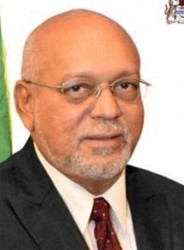As APNU stood its ground on its objections to the Amaila Falls Hydropower Project (AFHP) in its current form, President Donald Ramotar yesterday pledged that he would try to persuade the investors to stay on, while warning that the country could lose US$80M meant to be used as Guyana’s equity in the scheme.
Developer Sithe Global on Sunday formally announced its withdrawal over the project’s failure to win political consensus, in light of APNU’s decision to vote against parliamentary measures aimed at enabling the venture.
Ramotar, who has reached out to APNU leader David Granger to get the coalition to reverse its position on the project, yesterday said he hoped that APNU in particular “could see the bigger picture” and support the project.
“Sithe Global and Blackstone wanted full parliamentary support for this project because of the magnitude of their investment. Because of the lack of support from all the opposition parties, the country has lost the prestigious international partners’ support,” he said yesterday in a televised address to the nation.

“I want to thank all of you who supported this project and urge that you remain committed… I want you to know that I will continue to work to get cheaper energy for Guyana. I will continue to try to convince investors to stay on and invest in this project and in this country and I still hope that the opposition (particularly the APNU) could see the bigger picture and that they would put the interests of our people above narrow party lines and rise to the call to support this project,” he added.
Sithe’s exit from its agreement with the government to complete the Amaila Falls project has placed the project in jeopardy, particularly since much of the investment that was to be used to finance the project would have been sourced by the company.
To date, Sithe has invested approximately US$16 million in the development of the project, but was also expected to contribute an additional US$157 million in equity. In addition to these amounts however, a further US$175 million in loans that was to be sourced from the Inter-American Development Bank while US$ 500 million would have been sourced from the China Development Bank (CDB).
Essentially, when Sithe walked out on the project, the company took the financing with it.
Guyana’s contribution in equity would have amounted to US$100 million, US$80 million of which was attained via the forest protection deal with Norway and according to Ramotar, this amount “is in real danger of being lost.” The president also stated that Guyana, to date, has expended US$15 million on conducting the project’s preparatory work. “Much of this, it should be noted, was approved by the joint opposition in the 2012 budget. Now with their rejection of support for this project they have in essence wasted these funds,” Ramotar said, while lamenting the opposition’s “short-sighted position” and “a clear reluctance or inability to rise above narrow political agendas” to support national policies.
Ramotar pledged to work towards making the completion of the project a reality in his address yesterday. He said that he would “try to convince investors to stay on and invest in this project”.
Stabroek News understands though, that the door through which Sithe walked may not be closed. According to an analyst, the project can be salvaged with Sithe, since it is the one providing the majority of the financing, if it comes back on board, so will the equity it brings, as well as the loans to be had from the IDB and the CDB. The source said though, that the overall project cost, as well as several other elements would have to be reworked.
The source pointed out that even if a complete facelift of the project model, including the technical aspects, needs to be reworked, the government should not hesitate in getting this done. Finally, addressing the ultimatum given by Sithe – consensus on the project from all three parliamentary parties – the source said that it is curious that the company, having been in possession of the licence for several years, only recently named this condition as a pre-requisite for it to stay on-board.
He emphasised that the opposition parties had been kept abreast of all of the important details about the project and he stressed that the public debt from the project is zero.
He did not respond to some of the concerns raised by the opposition about assurances on the tariff to the consumer, the financing costs for the project and the ability of the Guyana Power and Light to deliver on the job.
Analysts Christopher Ram and Ramon Gaskin have encouraged the scrapping of the AFHP agreement as it is currently packaged, and a reversion of the process to re-tendering. This suggestion was made before the decision by APNU to vote down the Amaila related bill and motion after they were brought back to the National Assembly during last Wednesday’s sitting. The government however, had indicated that such a move could serve to deter prospective international investors from pointing their finances in Guyana’s direction.
Ramotar said government exerted great efforts to stress the importance of this project to the opposition parties and to all stakeholders in the country. “Sadly the opposition remained unconvinced,” he said.
“I cannot over-emphasise the fact that a successful hydro project will being direct and indirect benefits to every single Guyanese,” he added, while noting that, “cheap energy is vital to the industrialisation of Guyana. Industrialisation would create thousands of high quality jobs for all Guyanese, particularly young people.”
The opposition has said that it fully realises the benefits of hydroelectricity in Guyana. In particular, Granger and APNU’s spokesperson on finance Carl Greenidge have reiterated on several occasions that it was not opposed to hydroelectricity, but the way in which the Amaila Falls project was being conducted.









